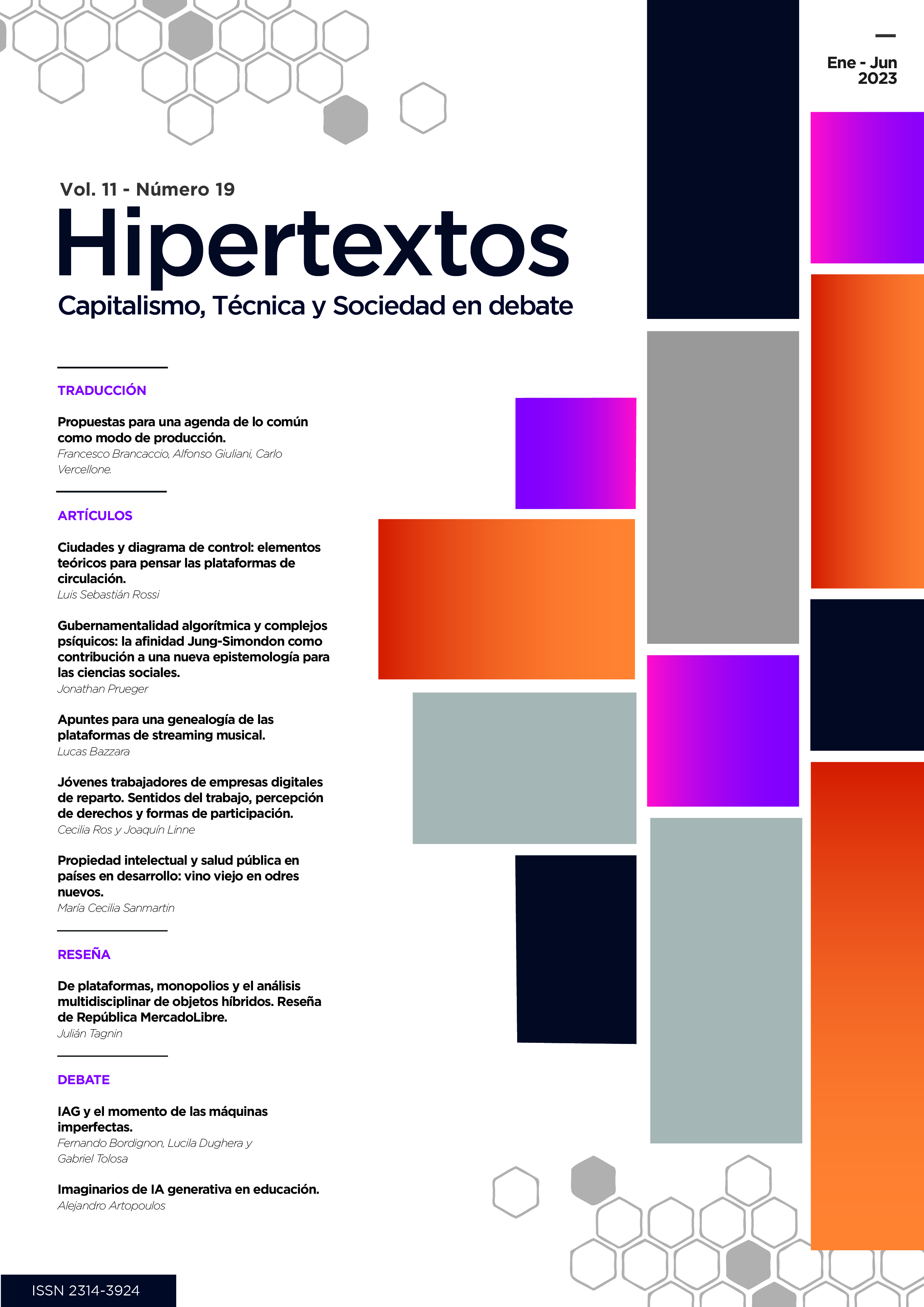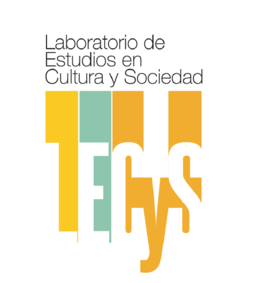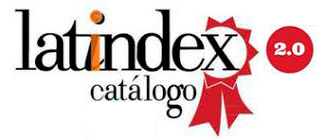Notes for a genealogy of music streaming platforms
DOI:
https://doi.org/10.24215/23143924e065Keywords:
Music streaming platforms, genealogy, sound technologies, listening modesAbstract
This paper will attempt to provide elements for a history of music streaming platforms. The genealogical perspective adopted will make it possible to establish the conditions of possibility under which these platforms emerged and consolidated. Although the object of study can be presented in a single and simple aspect, its procedence refers to a proliferation of heterogeneous events formed at different speeds; it will therefore be necessary to account not only for the historical continuities but also for the irregularities and interruptions that shake and disrupt this continuity. Hence, if from one point of view we can think of a linear and homogeneous temporality that would cover the technologies of sound recording and reproduction from their first manifestations to the present day (from the phonograph to Spotify), from another point of view -which would give itself the task of vertically cutting here and there the presumably uniform historical arc- it would be observed on the one hand that there is no relation of necessity in the passages from one technology to another, and on the other hand, that the technologies are not sufficient to explain these passages. Therefore, the historical approach presented here is based on a series of overlapping intertweavings that, starting in the last quarter of the 19th century, unfold, mutate, displace and generate the conditions of possibility for the emergence of platform music in the 21st century. The traced path will highlight the relationships between technologies, but it will also highlight the relationships between technologies and the disciplines, theories and discourses that support them, as well as the relationships between technologies, the socio-cultural practices associated with them and the music industry, without all of which music streaming platforms would not have been possible.
Downloads
References
Basso, G. (2001). Análisis Espectral. La transformada de Fourier en la música. Ediciones al Margen.
Becerra, M. (2003). Sociedad de la información: proyecto, convergencia, divergencia. Norma.
Benjamin, W. (2007). La obra de arte en la época de su reproductividad técnica”. Conceptos de filosofía de la historia. Terramar.
Borges, J. L. (1998). El asesino desinteresado Bill Harrigan. Historia universal de la infamia. Alianza..
Calasso, R. (2014). La marca del editor. Anagrama.
Capanna, P. (3 de mayo de 2008). Las afinidades electivas. Cibernética: Teorías del control. Suplemento Futuro. Página/12. https://www.pagina12.com.ar/diario/suplementos/futuro/13-1910-2008-05-03.html
Chion. M. (2019). Cómo la técnica modificó el sonido. El sonido. Oír, escuchar, observar. La marca editora.
Costa, F. (2017). Omnes et singulatim en el nuevo orden informacional. Gubernamentalidad algorítmica y vigilancia genética. Poliética, 5 (1), 40-73.
De Sola Pool, I. (1992). Discursos y sonidos de largo alcance. Historia de la Comunicación. Vol. 2. De la imprenta a nuestros días (R. Williams ed.). Bosch
Fox Keller, E. (2000). El cuerpo de una nueva máquina: situando el organismo entre los telégrafos y las computadoras. Lenguaje y vida. Metáforas de la biología en el siglo XX. Manantial.
Foucault, M. (1991). El juego de Michel Foucault. Saber y Verdad. Ediciones de La Piqueta.
Foucault, M. (1992). Nietzsche, la genealogía, la historia. Microfísica del poder. Ediciones de La Piqueta.
Foucault, M. (2006). Seguridad, territorio, población. Curso en el Collège de France (1977-1978). Fondo de Cultura Económica.
García, J. (20 de febrero de 2020). Quién está ganando la guerra del streaming de música. Xataka. https://www.xataka.com/empresas-y-economia/quien-esta-ganando-guerra-streaming-musica
Hui, Y. (2017). ¿Qué es un objeto digital? Revista Virtualis, 8 (15), 81-96.
Hui, Y. (2020). Fragmentar el futuro. Ensayos sobre tecnodiversidad. Caja Negra.
IFPI (2019). El estado de la industria. Informe Mundial de la Música.
Janssens, J., Van Daele, S. y Vander Beker, T. (2009). The Music Industry on (the) Line? Surviving Music Piracy in a Digital Era. European Journal of Crime, Criminal Law and Criminal Justice 17. Institute for International Research o Criminal Policy (IRCP): Ghent University.
Kassabian, A. (2013). Introduction. Ubiquitous Listening: Affect, Attention and Distributed Subjectivity. University of California Press.
Lévy, P. (2007). Nota introductoria. Cibercultura. Informe al Consejo de Europa. Anthropos.
Márquez, I. (2017). Nuevas prácticas de creación, distribución, consumo y ‘socialidad’. La ‘YouTubificación de la música’. Telos. Revista de Pensamiento sobre Comunicación, Tecnología y Sociedad, (106).
McLuhan, M. (2009). El medio es el mensaje. Comprender los medios de comunicación. Paidós.
Menn, J. (2003). All the Rave. The Rise and Fall of Shawn Fanning’s Napster. Crown Business.
Milojicic, D., Kalogeraki, V., Lukose, R., Nagaraja, K., Pruyne, J., Richard, B., Rollins, S. y Xu, Z. (2002). Peer-to-Peer Computing. HP Labs.
Moro Abadía, O. (2006). Introducción. La perspectiva genealógica de la historia. Universidad de Cantabria.
Oram, D. (ed.) (2001). Peer-to-Peer. Harnessing the power of disruptive technologies. O’Reilly & Associates.
Pohlmann, K. (1989). The compact disc. A handbook of theory and use. A-R Editions.
Raduoch, L. (2018). Technology and Innovation in the Music Industry: a Market Study. Economics Senior Thesis, Ithaca College.
Rodríguez, P. (2012). Historia de la información. Del nacimiento de la estadística y la matemática moderna a los medios masivos y las comunidades virtuales. Capital Intelectual.
Rodríguez, P. (2018). Gubernamentalidad algorítmica. Sobre las formas de subjetivación en la sociedad de los metadatos. Revista Barda, 4 (6), 14-35.
Ross, A. (2012). Máquinas infernales: de cómo las grabaciones cambiaron la música. Escucha Esto. Seix Barral.
Sadin, É. (2017). La humanidad aumentada. La administración digital del mundo. Caja Negra.
Sadin, É. (2018). La silicolonización del mundo. La irresistible expansión del liberalismo digital. Caja Negra.
Simondon, G. (2013). La invención. Imaginación e Invención. Cactus.
Srnicek, N. (2018). Capitalismo de plataformas. Caja Negra.
Sterne, J. (2003). The Audible Past. Cultural origins of sound reproduction. Duke University Press.
Sterne, J. (2006). The MP3 as cultural artifact. New Media & Society. 8 (5). Thousand Oaks, CA and New Delhi. 825-842. http://dx.doi.org/10.1177/1461444806067737
Sterne, J. (2012). MP3. The meaning of a format. Duke University Press.
Stiegler, B. (2015). La prueba de la impotencia: nanomutaciones, hypomnemata, gramatización. En J. Blanco, D. Parente, P. Rodríguez y A. Vaccari (Coords.), Amar a las máquinas. Cultura y técnica en Gilbert Simondon (pp. 139-170). Prometeo.
Sweney, M. (24 de abril de 2018). Slipping discs: music streaming revenues of $6.6bn surpass CD sales. The Guardian. https://www.theguardian.com/technology/2018/apr/24/music-streaming-revenues-overtake-cds-to-hit-66bn
Terranova, T. (2004). Network Dynamics. Network Culture: Politics for the Information Age. Pluto Press.
Terranova, T. (2017). Red Stack Attack! Algoritmos, capital y la automatización del común. En A. Avanessian y M. Reis (Comps.), Aceleracionismo. Estrategias para una transición hacia el postcapitalismo. Caja Negra.
Tiqqun (2013). La hipótesis cibernética. Hekht.
Variego, J. (2018). Composición algorítmica. Matemáticas y ciencias de la computación en la creación musical. Universidad Nacional de Quilmes Editorial.
Wiener, N. (1969). Cibernética y Sociedad. Sudamericana.
Wisnik, J.M. (2015). Física y metafísica del sonido. Sonido y sentido. Otra historia de la música. La marca editora.
Witt, S. (2016). Cómo dejamos de pagar por la música. El fin de la industria, el cambio de siglo y el paciente cero de la piratería. Contra.
Zuazo, N. (2015). Guerras de internet. Un viaje al centro de la red para entender cómo afecta tu vida. Debate.
Downloads
Published
How to Cite
Issue
Section
License

This work is licensed under a Creative Commons Attribution-NonCommercial-NoDerivatives 4.0 International License.
























